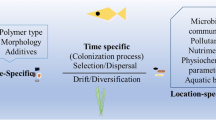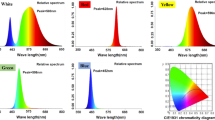Abstract
Phytoplankton blooms can cause acute effects on marine ecosystems due either to their production of endogenous toxins or to their enormous biomass leading to major impacts on local economies and public health. Despite years of effort, the causes of these Harmful Algal Blooms are still not fully understood. Our hypothesis is that bacteria that produce photoactive siderophores may provide a bioavailable source of iron for phytoplankton which could in turn stimulate algal growth and support bloom dynamics. Here we correlate iron concentrations, phytoplankton cell counts, bacterial cell abundance, and copy numbers for a photoactive siderophore vibrioferrin biosynthesis gene in water samples taken from 2017 cruises in the Gulf of California, and the Pacific Ocean off the coast of northern Baja California as well as during a multiyear sampling at Scripps Pier in San Diego, CA. We find that bacteria producing the photoactive siderophore vibrioferrin, make up a surprisingly high percentage of total bacteria in Pacific/Gulf of California coastal waters (up to 9%). Vibroferrin’s unique properties and the widespread prevalence of its bacterial producers suggest that it may contribute significantly to generating bioavailability of iron via photoredox reactions.








Similar content being viewed by others
References
Abualhaija MM, van den Berg CMG (2014) Chemical speciation of iron in seawater using catalytic cathodic stripping voltammetry with ligand competition against salicylaldoxime. Mar Chem 164:60–74
Almazán-Becerril A, García-Mendoza E (2008) Maximum efficiency of charge separation of photosystem II of the phytoplankton community in the Eastern Tropical North Pacific off Mexico: a nutrient stress diagnostic tool? Cienc Mar 34(1):29–43
Amin SA, Küpper FC, Green DH, Harris WR, Carrano CJ (2007) Boron binding by a siderophore isolated from marine bacteria associated with the toxic dinoflagellate Gymnodinium catenatum. J Am Chem Soc 129(3):478–479
Amin SA, Green DH, Hart MC, Küpper FC, Sunda WG, Carrano CJ (2009a) Photolysis of iron–siderophore chelates promotes bacterial–algal mutualism. Proc Natl Acad Sci USA 106(40):17071–17076
Amin SA, Green DH, Küpper FC, Carrano CJ (2009b) Vibrioferrin, an unusual marine siderophore: Iron binding, photochemistry, and biological implications. Inorg Chem 48:11451–11458
Amin SA, Green DH, Gärdes A, Romano A, Trimble L, Carrano CJ (2012) Siderophore-mediated iron uptake in two clades of Marinobacter spp. associated with phytoplankton: the role of light. Biometals 25:181–192
Bach HJ, Toman J, Schloter M, Munch JC (2002) Enumeration of total bacteria and bacteria with genes for proteolytic activity in pure cultures and in environmental samples by quantitative PCR mediated amplification. J Microbiol Methods 49(3):235–245
Barbeau K, Rue EL, Bruland KW, Butler A (2001) Photochemical cycling of iron in the surface ocean mediated by microbial iron(iii)-binding ligands. Nature 413:409–413
Barbeau K, Zhang G, Live DH, Butler A (2002) Petrobactin, a photoreactive siderophore produced by the oil-degrading marine bacterium Marinobacter hydrocarbonoclasticus. J Am Chem Soc 124(3):378–379
Biers EJ, Sun S, Howard EC (2009) Prokaryotic genomes and diversity in surface ocean waters: Interrogating the global ocean sampling metagenome. Appl Environ Microbiol 75(7):2221–2229
Bruland KW, Donat JR, Hutchins DA (1991) Interactive influences of bioactive trace metals on biological production in oceanic waters. Limnol Oceanogr 36(8):1555–1577
Buck KN, Moffett J, Barbeau KA, Bundy RM, Kondo Y, Wu J (2012) The organic complexation of iron and copper: an intercomparison of competitive ligand exchange–adsorptive cathodic stripping voltammetry (CLE-ACSV) techniques. Limnol Oceanogr 10:496–515
Challis GL (2005) A widely distributed bacterial pathway for siderophore biosynthesis independent of nonribosomal peptide synthetases. Chem Bio Chem 6:601–611
Gärdes A, Triana C, Amin SA, Green DH, Romano A, Trimble L, Carrano CJ (2013) Detection of photoactive siderophore biosynthetic genes in the marine environment. Biometals 26:507–516
Grossart H-P, Levold F, Allgaier M, Simon M, Brinkhoff T (2005) Marine diatom species harbour distinct bacterial communities. Environ Microbiol 7(6):860–873
Hallegraeff GM, Fraga S (1998) Bloom dynamics of the toxic dinofagellate Gymnodinium catenatum, with emphasis on Tasmanian and Spanish coastal waters. In: Anderson DM, Cembella AD, Hallegrae GM (eds) Physiological ecology of harmful algal blooms, vol 41. Springer, Berlin, pp 59–80
Heukelem LV, Thomas CS (2001) Computer-assisted high-performance liquid chromatography method development with applications to the isolation and analysis of phytoplankton pigments. J Chromatogr A 910:31–49
Küpper FC, Carrano CJ, Kuhn J-U, Butler A (2006) Photoreactivity of iron(III)-aerobactin: photoproduct structure and iron(III) coordination. Inorg Chem 45:6028–6033
Labrenz M, Brettar I, Christen R, Flavier S, Bötel J, Höfle MG (2004) Development and application of a real-time PCR approach for quantification of uncultured bacteria in the central Baltic Sea. Appl Environ Microbiol 70(8):4971–4979
Maldonado MT, Strzepek RF, Sander S, Boyd PW (2005) Acquisition of iron bound to strong organic complexes, with different Fe binding groups and photochemical reactivities, by plankton communities in Fe-limited subantarctic waters. Global Biogeochem Cycles. 19, GB4S23
Martin JH, Fitzwater SE (1988) Iron deficiency limits phytoplankton growth in the north-east Pacific subarctic. Nature 331:341–343
Moore JK, Braucher O (2007) Observations of dissolved iron concentrations in the World Ocean: implications and constraints for ocean biogeochemical models. Biogeosci Discuss 4:1241–1277
Naito K, Imai I, Nakahara H (2008) Complexation of iron by microbial siderophores and effects of iron chelates on the growth of marine microalgae causing red tides. Phycol Res 56:58–67
Raven JA (2013) Iron acquisition and allocation in stramenopile algae. J Exp Bot 64(8):2119–2127
Raymond KN, Allred BE, Sia AK (2015) Coordination chemistry of microbial iron transport. Acc Chem Res 48(9):2496–2505
Ritalahti KM, Amos BK, Sung Y, Wu Q, Koenigsberg SS, Löffler FE (2006) Quantitative PCR targeting 16S rRNA an reductive dehalogenase genes simultaneously monitors multiple Dehalococcoides strains. App Environ Microbiol 72(4):2765–2774
Rooney-Varga J, Giewat M, Savin M, Sood S, LeGresley M, Martin J (2005) Links between phytoplankton and bacterial community dynamics in a coastal marine environment. Microb Ecol 49(1):163–175
Rusch DB, Halpern AL, Sutton G, Heidelberg KB, Williamson S, Yooseph S et al (2007) The Sorcerer II Global Ocean Sampling expedition: northwest Atlantic through eastern tropical Pacific. PLoS Biol 5(3):e77
Sandy M, Butler A (2009) Microbial iron acquisition: marine and terrestrial siderophores. Chem Rev 109:4580–4595
Sutak R, Botebol H, Blaiseau P-L, Léger T, Bouget F-Y, Camadro J-M, Lesuisse E (2012) A comparative study of iron uptake mechanisms in marine microalgae: iron binding at the cell surface is a critical step. Plant Physiol 160:2271–2284
Tillett, D., & Neilan, B. A. (2000). Xanthogenate Nucleaic Acid Isolation from Cultured and Environmental Cyanobacteria. J. Phycol., 36
Vraspir JM, Butler A (2009) Chemistry of marine ligands and siderophores. Ann Rev Mar Sci 1:43–63
Wu J, Luther GW III (1994) Size-fractionated iron concentrations in the water column of the western North Atlantic Ocean. Limnol Oceanogr 39(5):1119–1129
Yamamoto S, Okujo N, Yoshida T, Matsuura S, Shinoda S (1994) Structure and iron transport activity of vibrioferrin, a new siderophore of Vibrio parahaemolyticus. J Biochem 115:868–874
Yarimizu K, Polido G, Gärdes A, Carter ML, Hilbern M, Carrano CJ (2014) Evaluation of photo-reactive siderophore producing bacteria before, during and after a bloom of the dinoflagellate Lingulodinium polyedrum. Metallomics 6:1156–1163
Yilmaz M, Phlips EJ (2009) Improved methods for the isolation of cyanobacterial DNA from environmental samples. J Phycol 45:517
Acknowledgements
We would like to acknowledge the members of the Marine Ficotoxins Laboratory at CICESE for helping us sampling and providing us the hydrographic data. We would like to thank Professor Helmut Maske from the Marine Microbes Laboratory at CICESE for use of his facilities and César Almeda for his assistance with the maps. We specially acknowledge Baja Aqua Farms Co. for sponsoring the entire Pacific Ocean research cruise. This work was supported in part by grant CHE-1664657 from the National Science Foundation. RCL was partially supported by the National Council of Science and Technology (CONACYT-México) project FORDECYT M0037-2015-02-260040 (to EGM), and a Postdoctoral fellowship for overseas (CONACYT-México). The Scripps Pier phytoplankton cell counts and chlorophyll concentrations were collected as part of the Southern California Coastal Ocean Observing System, Harmful Algal Bloom Monitoring Program with support in part by grant NOAA-NA16NOS0120 from the National Oceanic and Atmospheric Administration.
Author information
Authors and Affiliations
Corresponding author
Additional information
Publisher's Note
Springer Nature remains neutral with regard to jurisdictional claims in published maps and institutional affiliations.
Electronic supplementary material
Below is the link to the electronic supplementary material.
Rights and permissions
About this article
Cite this article
Yarimizu, K., Cruz-López, R., García-Mendoza, E. et al. Distribution of dissolved iron and bacteria producing the photoactive siderophore, vibrioferrin, in waters off Southern California and Northern Baja. Biometals 32, 139–154 (2019). https://doi.org/10.1007/s10534-018-00163-3
Received:
Accepted:
Published:
Issue Date:
DOI: https://doi.org/10.1007/s10534-018-00163-3




